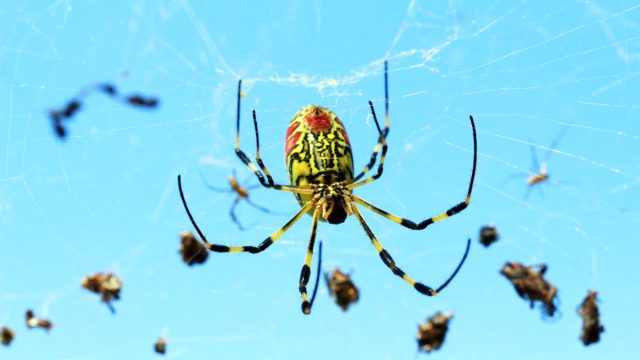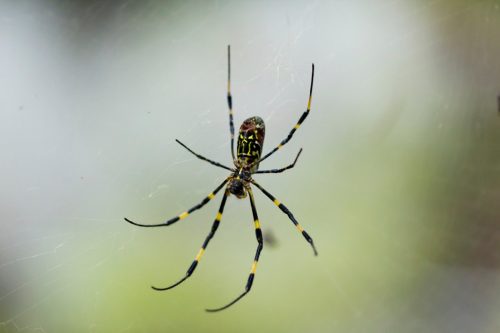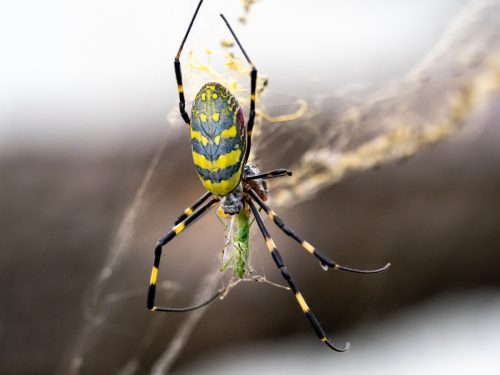If You Live Here, Prepare to See This Spider in “Extreme Numbers”

If you’ve been extra observant, you may have noticed more spiders around your home lately. Spiders appear more often in the fall because it’s their mating season, which means you might spot them roaming around your house looking for a beau, according to DC Scientific Pest Control. They may also be moving indoors in search of warmth during the colder months, though most of the spiders you see have likely already been hiding in your home for some time now. But depending on where you live, you may see even more spiders than you’re used to this fall. Read on to find out where experts warn one invasive spider is taking over in “extreme numbers.”
RELATED: If You’re Not Cleaning These 2 Spots, You’re Attracting Spiders to Your Home.
The invasive Joro spider is taking over the state of Georgia.

Joro spiders surfaced in Georgia around 2015, when they were first identified by Rick Hoebeke and Byron Freeman, Georgia Museum of Natural History’s collections manager and director, according to the University of Georgia (UGA). Since then, the spider has grown to “extreme numbers” within the state, as they’ve been sighted in nearly 25 different counties, Michele Hatcher, a member of the University of Georgia Department of Entomology, told USA Today.
“We’ve been getting lots of calls and emails from people reporting sightings,” Freeman said in a statement. “They seem to be really common in riparian areas and in urban areas around people’s houses, but they’re also in the deep woods.”
The Joro spider is an invasive species in the U.S., as it is native to Asia. It’s likely the spiders made it to the country by riding from China or Japan in a shipping container, according to UGA.
RELATED: If You Live in These States, Watch Out for the World’s Largest Spider.
Joro spiders are rather large in size.

UGA says that Joro spiders can measure up to almost 3 inches across when their legs are fully extended, so they’re really “hard to miss” due to their larger size. They’re most noticeable by their distinctive yellow, blue, and black stripes on their backs and legs, but some do just have solid black legs, according to Freeman. A unique red marking is also located on their undersides.
In terms of webs, Joro spiders create enormous three-dimensional webs that are golden and tend to be built higher off the ground than some other spiders’. UGA also notes that this spider travels by ballooning, allowing the wind to carry it on a strand of its cobwebs.
But this spider isn’t likely to bite you.

While none of us want to encounter a horde of spiders, the Joro spider isn’t all that dangerous to humans. Nancy Hinkle, PhD, an entomologist for the University of Georgia, told USA Today that this spider isn’t really interested in biting people. As Freeman explained to UGA, “All spiders have venom that they use to subdue prey. If you put your hand in front of one and try to make it bite you, it probably will. But they run if you disturb their web. They’re trying to get out of the way.”
Instead, Hinkle says Joro spiders can serve as valuable “pest control,” as they feed on other bothersome pests, such as mosquitoes and flies. The spider even feeds on the invasive adult brown marmorated stink bugs, which “can infest houses and damage crops,” per UGA.
“Joro spiders present us with excellent opportunities to suppress pests naturally, without chemicals,” Hinkle told USA Today. “I’m trying to convince people that having zillions of large spiders and their webs around is a good thing.”
RELATED: For more pest news delivered straight to your inbox, sign up for our daily newsletter.
The spider has also been spotted in one neighboring state.

While the main invasion appears to be occurring in Georgia, residents from neighboring states should be prepared to see this spider crossing state lines. UGA says the spider has reached as far afield as Greenville, South Carolina. “I think people need to make peace with Joros and accept the spiders because they are not going anywhere,” Hoebeke told USA Today.
Despite being an invasive species, these spiders don’t need to be killed. Experts believe their population growth will become naturally suppressed eventually. Hinkle told USA Today that most Joro spiders will die off in November, but they are likely to lay eggs, so more spiders may arise again in the springtime. For his part, Freeman did advise that experts don’t yet know “what the impact is going to be,” and if these spiders will turn more troublesome, like the invasive spotted lanternfly or adult brown marmorated stink bugs.
RELATED: If You See This Spider in Your Home, Don’t Step on It, Experts Warn.